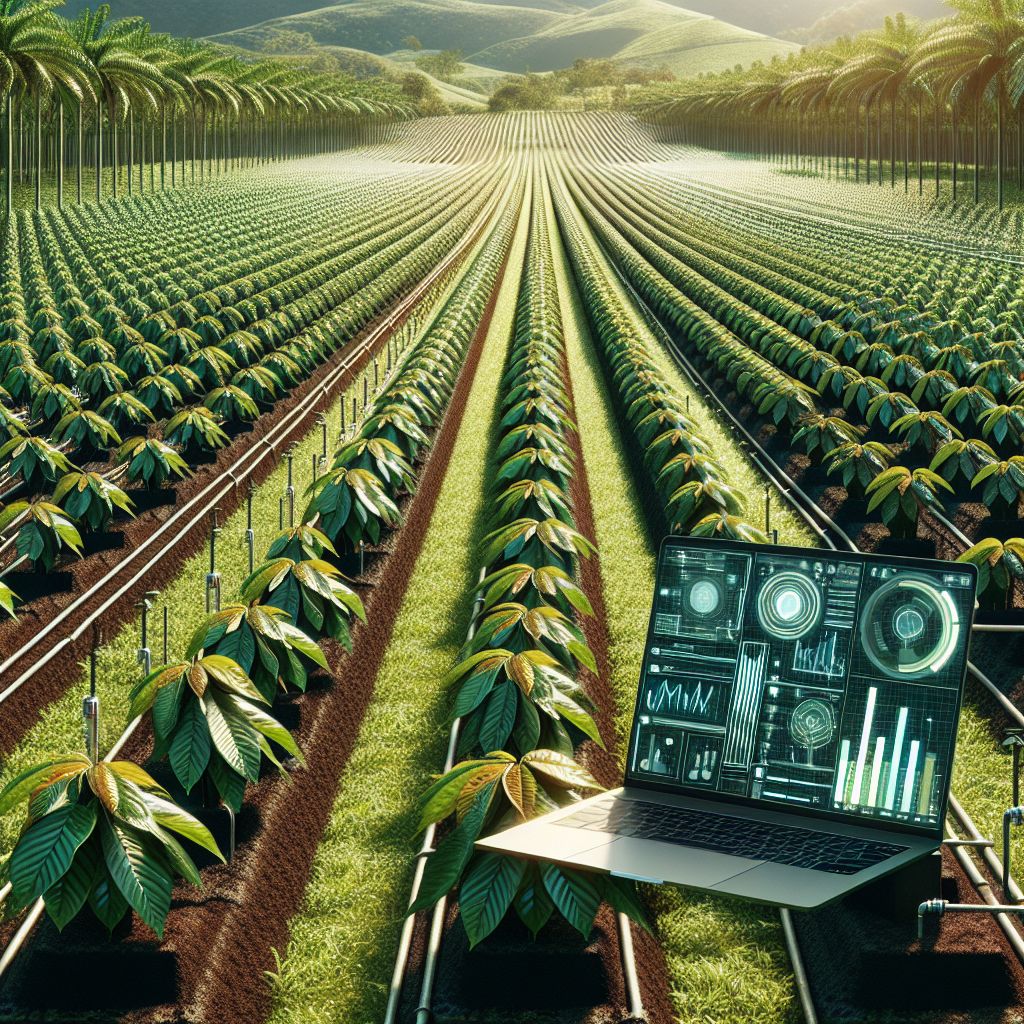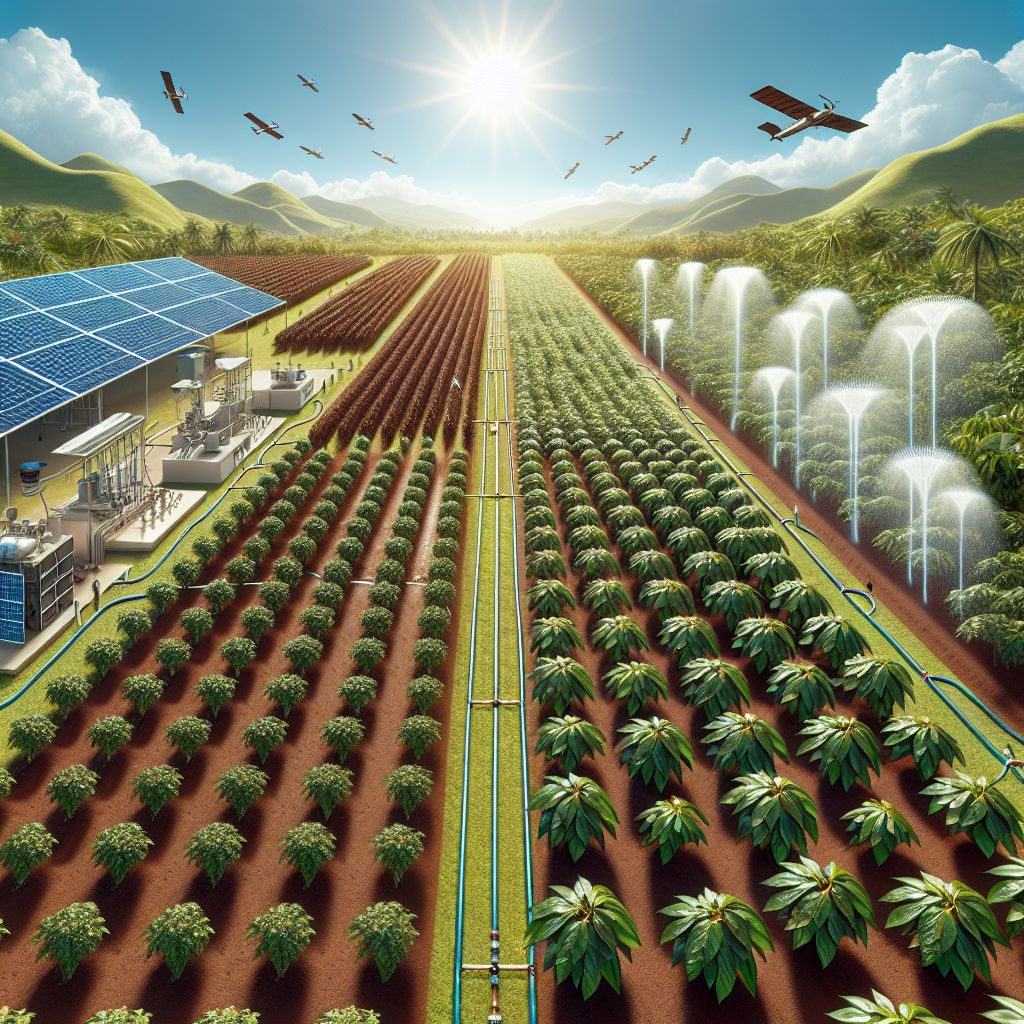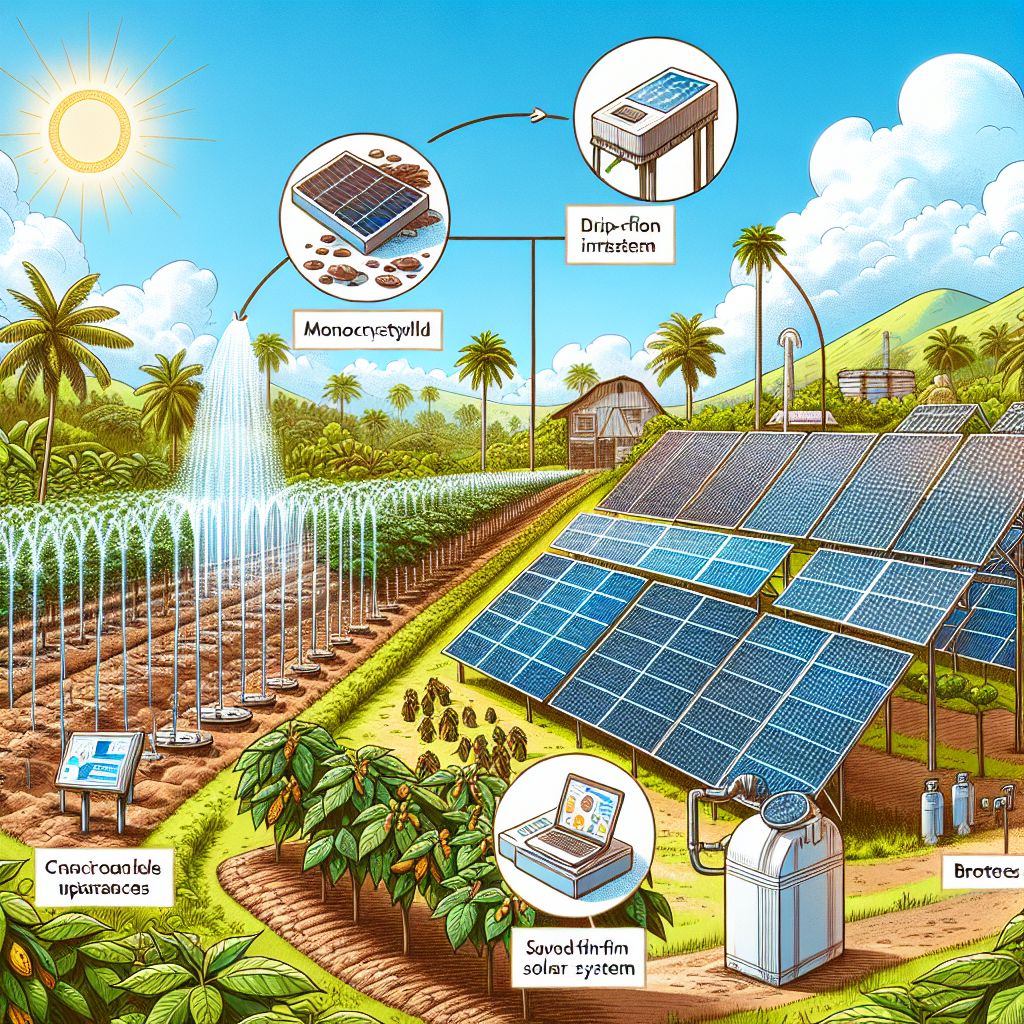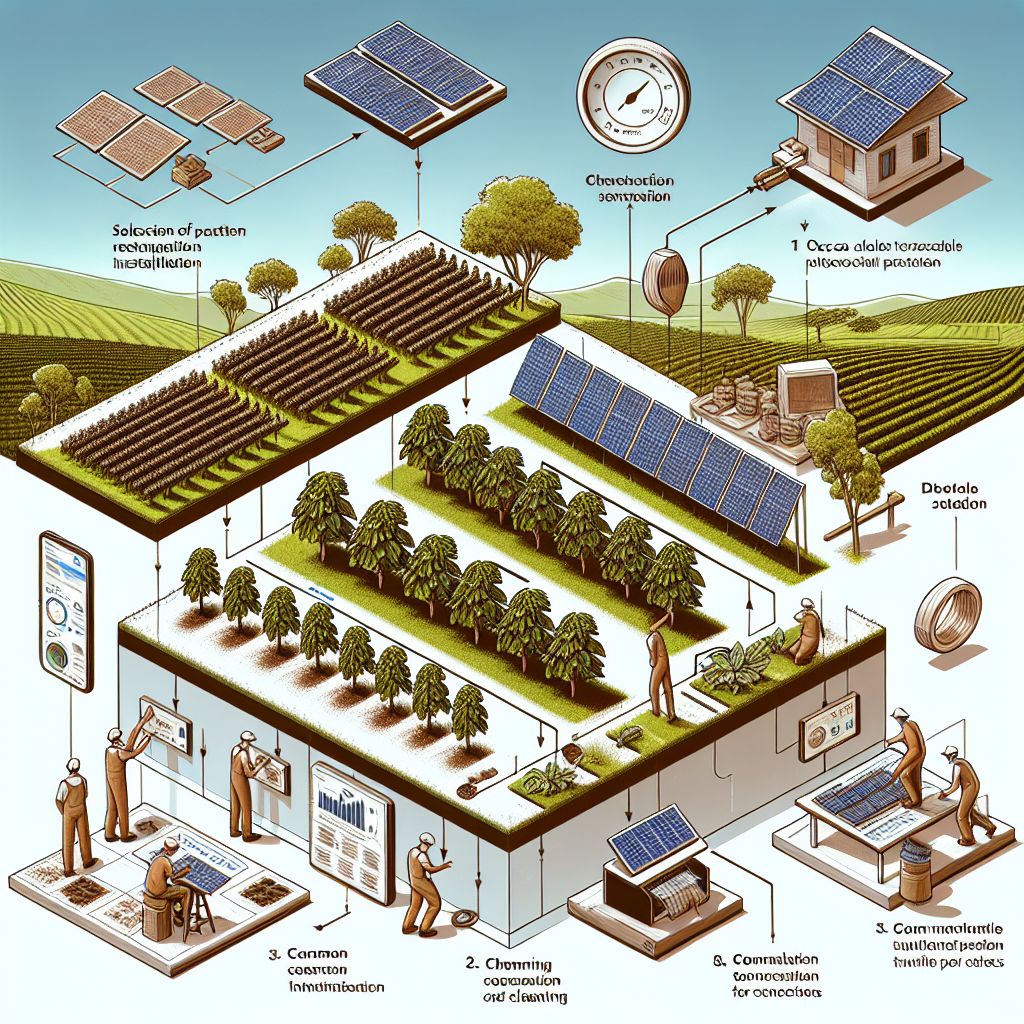
Main Points
Effective watering systems are critical for cocoa cultivation, particularly in regions where water is scarce.
Drip irrigation is the most water-saving approach, as it delivers water straight to the cocoa tree’s roots.
Climate change is making water management in cocoa cultivation increasingly important.
Solar-powered watering systems can improve efficiency and sustainability.
Advanced technology and AI can assist in optimizing watering schedules for cocoa plantations.
The Importance of Water Efficiency in Cocoa Farms
Water is like the life force of cocoa farms—it’s necessary. However, not all places are abundant in water, and that’s where efficiency comes into play. Efficient watering is about making every drop matter. This is particularly true for cocoa, which requires constant moisture to flourish. By using water wisely, we can cultivate cocoa more sustainably, ensuring that this tasty resource will be around for future generations.
Water efficiency is not only beneficial to the environment but it also helps to save money. By using less water, we save on resources and potentially increase the yield and quality of the cocoa. As a result, efficient irrigation systems are beneficial to both the farmer and the environment.
Water Shortages and Cocoa Farms
Water shortages are becoming more common around the world, and cocoa farms are no exception. In some of the biggest cocoa-growing areas, like West Africa, water is becoming more and more valuable. Effective watering makes sure that cocoa trees get the water they need, even during droughts, without wasting any water.
Climate Change’s Effect on Water Supply
Climate change is causing unexpected and extreme weather patterns, such as droughts and floods. Cocoa farmers have to be prepared for all possibilities. Efficient irrigation systems can help cocoa farms survive these extreme weather events by using water more wisely.
The Cost-Effectiveness of Water Efficiency in Cocoa Farming
A drip irrigation system can drastically cut down on water waste compared to conventional methods.
Putting money into efficient irrigation can result in long-term cost reductions and increased cocoa output.
Solar-powered systems might have higher initial costs, but they can provide decreased energy costs over time.
Now, let’s delve further into the realm of cocoa irrigation and discover how to keep those cocoa trees quenched and content.

Quenching Cocoa’s Thirst: Irrigation Requirements
Just like any other plant, cocoa trees need water to grow. However, they don’t like being overwatered—too much water can be just as harmful as not enough. The secret is maintaining a consistent level of moisture. Cocoa trees need a constant supply of water during the dry season and just prior to the harvest to ensure the highest quality beans.
“Cocoa trees require steady hydration, especially during the dry season and before harvest, to produce high-quality beans.”
In addition, it’s important to know the moisture needs of the soil and how they can vary throughout the year. This understanding allows us to tailor watering schedules to the growth stages of the cocoa tree and the local weather conditions.
Water Needs of Cocoa Plants
Cocoa plants thrive in soil that is damp, but not waterlogged. The ideal scenario is one in which the roots can get to the water and nutrients they need without the danger of decay. This is where drip irrigation comes into its own. It supplies water straight to the roots, minimising the chance of overwatering and water evaporation.
Understanding the Watering Needs Based on Seasons
When the rains pour, you might not need to water your cocoa trees at all. However, when the dry season arrives, your trees will rely on you for their water supply. This is why it is crucial to understand the local weather patterns and adjust your watering schedule accordingly.
How to Determine the Water Needs of Cocoa Plants
Wondering how much water your cocoa trees need? One option is to use soil moisture sensors. These useful devices provide a real-time view of the moisture levels in your soil, allowing you to water your trees just the right amount. Another way is to keep an eye on the plants themselves; wilted leaves or slow growth can be signs of water stress.
Now that we know how much water cocoa trees need, let’s look at the different irrigation systems we can use.

Selecting the Best Irrigation System for Your Cocoa Farm
Choosing the best irrigation system for your cocoa farm is similar to selecting the perfect pair of shoes. It has to fit just right. You have two primary options: drip or sprinkler systems. Each has its advantages and disadvantages, but one might be a better fit for your farm.
Think of drip irrigation as a slow, gentle rain for your cocoa tree’s roots. It’s about precision, delivering water exactly where it’s needed without wasting a drop. Conversely, sprinkler systems are more like a shower for your entire cocoa field. They cover a larger area and might be simpler to install, but they don’t offer the same level of precision as drip systems.
Drip vs. Sprinkler Systems: A Comparison
In the world of cocoa Irrigation, drip and sprinkler systems are the two major players. Drip systems are designed for accuracy, providing water directly to the plant’s base. This minimizes water waste and helps to keep diseases at bay that flourish in damp leaves. Sprinkler systems, conversely, mimic rainfall, watering a large space and often cost less to set up.
However, let’s get down to brass tacks. Drip irrigation systems can conserve up to 60% more water than sprinklers because they reduce evaporation and runoff. Sprinklers may be less precise, but they can be a good choice if you’re working with a larger, flat area and have less labor available for system upkeep.
Understanding the Advantages of Micro-Sprinkler Irrigation
Micro-sprinkler irrigation is another option that offers the best of both worlds. It’s essentially a smaller version of a sprinkler system that combines the water efficiency of drip systems with the wider coverage of sprinklers. This type of irrigation is particularly beneficial for young cocoa plants, as it provides a gentle spray that can nurture their fragile early stages of development. For those interested in the integration of sustainable technology with irrigation, solar-powered irrigation systems are an emerging solution that can enhance crop yield and health.
Which Irrigation System is Best for Cocoa Farming: Drip or Micro-Sprinkler?
The best system for your cocoa farm depends on a few things. If you’re focused on saving water and your farm has a lot of hills and valleys, drip systems are the way to go. But if you need to water a large area fast and your farm is flat, micro-sprinklers might be a better fit.
Optimizing Irrigation Timings for Optimum Results
No matter the system you opt for, optimizing your irrigation timing is crucial. You’ll need to consider aspects such as the age of your cocoa trees, the type of soil, and the climate. For instance, younger trees require regular, smaller quantities of water, while older trees can cope with larger, less regular watering. By personalizing your timing, you can increase your farm’s water efficiency and cocoa production.
|
Irrigation Method |
Pros |
Cons |
|---|---|---|
|
Drip Irrigation |
– Highly water efficient, minimizes evaporation and runoff 1, 2 |
– Initial installation costs can be high |
|
Sprinkler Systems | – Covers large areas efficiently 1 |
– Higher water usage compared to drip1 |
|
Micro-Sprinkler Systems | – Low pressure, delivers water close to tree base 1, 3 |
– May not cover as large an area as full sprinkler systems |

Boosting Your Irrigation System’s Efficiency with Solar Panels
Next, we’ll discuss how to power your irrigation system. Solar panels can significantly improve your farm’s sustainability. They use the sun’s energy, which is plentiful in many areas where cocoa is grown, to operate your irrigation system. This can lower your fuel expenses and decrease your carbon emissions.
Not only are solar panels beneficial to the environment, but they are also a smart economic choice. While there is an initial investment, solar panels have a long life and can provide free energy for many years, reducing your operating costs over time.
Examining the Various Kinds of Solar Panels for Cocoa Cultivation
There are many different types of solar panels to choose from. Monocrystalline panels are highly efficient and work well in high-temperature climates, which are typical in areas where cocoa is grown. Polycrystalline panels are a more cost-effective option, but they are slightly less efficient. Thin-film solar is another option, which is flexible and easy to install, but it is the least efficient. The type of solar panel you choose will depend on your budget, the amount of space you have, and your energy needs.
|
Solar Panel Type |
Pros |
Cons |
|---|---|---|
|
Monocrystalline Silicon |
– High efficiency (15-22%). 4 |
– Higher upfront cost compared to other types 4 |
|
Polycrystalline Silicon |
– Lower manufacturing costs 4 |
– Lower space-efficiency than monocrystalline 1, 4 |
|
Thin-Film (e.g. Amorphous Silicon, CdTe, CIGS) |
– Low manufacturing costs4 |
– Lower efficiency (7-13%). 4 |
When integrating solar panels with irrigation systems for cocoa farming, factors like water pumping requirements, shading from cocoa trees, and overall energy needs should be considered. Drip irrigation systems are highly efficient and can work well with solar power due to their low operating pressures (1, 2). Proper system design is crucial to ensure the solar panels can adequately power the irrigation pumps and controllers.
Using Solar Energy in Irrigation
Using solar energy in irrigation is more than just placing some panels on the ground. You need to determine how much energy you need, know the local weather, and you may need to buy batteries to store extra power for use on cloudy days or at night.
Evaluating the Financial Implications of Solar-Powered Irrigation
It’s crucial to weigh the pros and cons of solar-powered irrigation systems before you make a decision. You’ll need to compare the upfront costs of installing solar panels with the potential savings on your energy bills over time. Also, be sure to check for any subsidies or incentives that might be available to you for investing in renewable energy. These can make solar power an even more attractive option.
Case Study: Solar Irrigation Success Stories
“A cocoa farm in Ghana switched to solar-powered drip irrigation and saw a 30% increase in yield while cutting energy costs by half. This demonstrates the potential of combining efficient irrigation with renewable energy.”

Setting Up and Maintaining Cocoa Solar Irrigation Systems
Setting up a solar irrigation system is a significant move, but it’s feasible with the right plan. Start with a site assessment to determine the best location for your panels, and then work with a professional to design a system that meets your farm’s needs. Once it’s set up, regular maintenance is crucial to keeping everything running smoothly.
Guide on How to Set Up Your System
Identify your energy needs and the layout of your plantation.
Choose the solar panel that is best suited to your needs.
Work with a professional installer to design and install your system.
Install a monitoring system to keep track of how much energy is being produced and used.
Regularly check and clean your panels to ensure they are working as efficiently as possible.
Troubleshooting Tips for Solar Irrigation Equipment
Even the most reliable systems can encounter problems. If your solar irrigation system isn’t working as it should, check for common problems like dirty panels, loose connections, or panels that are in the shade. Sometimes, all it takes is a reset or a quick clean to get things working again.
Keeping Your System Running for Years to Come
It’s important to have a long-term maintenance plan in place to keep your solar irrigation system running smoothly for as long as possible. This should include regular cleanings, inspections for damage, and part replacements when necessary. With the right care, your system can last for many years, providing sustainable energy to help your cocoa trees thrive.

Modern Strategies and Breakthroughs in Cocoa Irrigation
Lastly, let’s examine the frontier of cocoa irrigation. Intelligent technology and artificial intelligence (AI) are revolutionizing the industry. They can automate water efficiency, forecast optimal watering schedules, and even adjust to fluctuating weather conditions on the spot.
Intelligent Tech: Streamlining Water Conservation
Intelligent irrigation systems utilize sensors and controllers to keep an eye on soil dampness and weather situations, modifying watering schedules as needed to ensure plant well-being. This not only conserves water but also cuts down on labor expenses and eliminates any guesswork.
To sum up, a good irrigation system is the bedrock of sustainable cocoa farming. By selecting the appropriate system, tailoring your watering schedule, and incorporating intelligent technology, you can cultivate cocoa that is not only mouth-watering but also eco-friendly. Keep in mind, every drop of water is valuable, so let’s use it wisely!
How AI is Helping to Predict Watering Schedules
Artificial intelligence is changing the game when it comes to cocoa farming, and that includes how we water our plants. AI can take in a ton of data on weather, soil moisture, and plant health to figure out the best watering schedule. This way, we’re always one step ahead, giving our cocoa trees the perfect amount of water exactly when they need it.
Thanks to AI, we can now modify our irrigation methods on the spot. If there’s a sudden heatwave or drought, the AI system can give us a heads up and change the watering timetable to balance it out, making sure our cocoa trees stay stress-free and in good health.
The Rise of Solar Irrigation in Cocoa Farming
There is a growing interest in solar irrigation within the cocoa farming industry. This is largely due to the fact that it is not only a sustainable method of irrigation, but it is also cost-effective over time and aligns with the global shift towards renewable energy. By using solar panels to power irrigation systems, cocoa farms are not adding to the issue of carbon emissions, but are instead helping to combat it.
Final Thoughts:
In conclusion, the future of cocoa farming relies heavily on the implementation of efficient irrigation systems. With a variety of options available, from drip irrigation that provides water directly to the roots of the plants, to solar-powered systems that utilize the power of the sun, sustainable cocoa farming is becoming more achievable. By adopting these new technologies, cocoa farmers can expect not only to see an improvement in their crop yields and quality but also to contribute to a more sustainable planet.
Important Discoveries and Suggestions for Cocoa Growers
Water conservation is crucial for the longevity of cocoa cultivation.
For their accuracy and ability to save water, drip irrigation systems come highly recommended.
Opting for solar-powered irrigation can cut down on operational expenses and reduce carbon emissions, making it a wise choice for the future.
Artificial intelligence and advanced technology can enhance irrigation schedules, boosting water efficiency and increasing crop production.
For cocoa farming to be successful and sustainable in the long run, it’s important to keep irrigation technology up-to-date and well-maintained.
How Solar Irrigation is Shaping the Future of Cocoa Farming
With the integration of solar irrigation, cocoa farming is set to have a brighter future. As technology continues to evolve, we can anticipate the emergence of more innovative solutions that will lessen the environmental footprint of cocoa farming and aid farmers in adapting to the challenges brought about by climate change.
By choosing the best irrigation systems and putting in the necessary time and resources, cocoa farming can continue to thrive. This ensures that we still have the cocoa beans we need for our favorite chocolate snacks, while also protecting the environment for future generations.
Common Questions
Why should I use a drip irrigation system for my cocoa plants?
Using a drip irrigation system for your cocoa plants has many advantages. It delivers water directly to the plant’s root zone, which reduces water waste from evaporation and runoff. It also keeps the leaves dry, which can help prevent diseases. Plus, it allows you to apply water and nutrients very precisely, which can make your plants healthier and increase your yield.
Is it possible to grow cocoa in areas with water shortages?
Indeed, cocoa can be grown in areas with water shortages by using water-efficient irrigation systems such as drip or micro-sprinkler systems. These systems make sure that water is used wisely and effectively, maximizing the yield per drop. In addition, mulching and soil moisture conservation methods can also increase water efficiency.
Using solar-powered watering systems is a great way to increase efficiency. It reduces the need for non-renewable energy sources and cuts down on the costs of pumping water.
How often should cocoa farms replace their solar irrigation systems?
Cocoa farms should consider replacing their solar irrigation systems every few years to benefit from improvements in efficiency and cost. Regular upkeep and checks can help determine when replacements or improvements are necessary to keep the system working at its best.
Is there financial help or rewards for using solar-powered irrigation?
Yes, there is usually financial help or rewards available for using solar-powered irrigation systems. These can be government grants, tax reductions, or subsidies that encourage the use of renewable energy in farming. Farmers should check with local authorities or agricultural extension services to find out about programs in their area.
How can advanced technology enhance water usage efficiency in cocoa farming?
Advanced technology can enhance water usage efficiency in cocoa farming by utilizing sensors and data analysis to keep track of soil moisture and environmental conditions. This enables the accurate timing of irrigation events, guaranteeing that water is only used when necessary and in the correct quantities, thereby preventing overwatering and wastage.







Leave a Reply